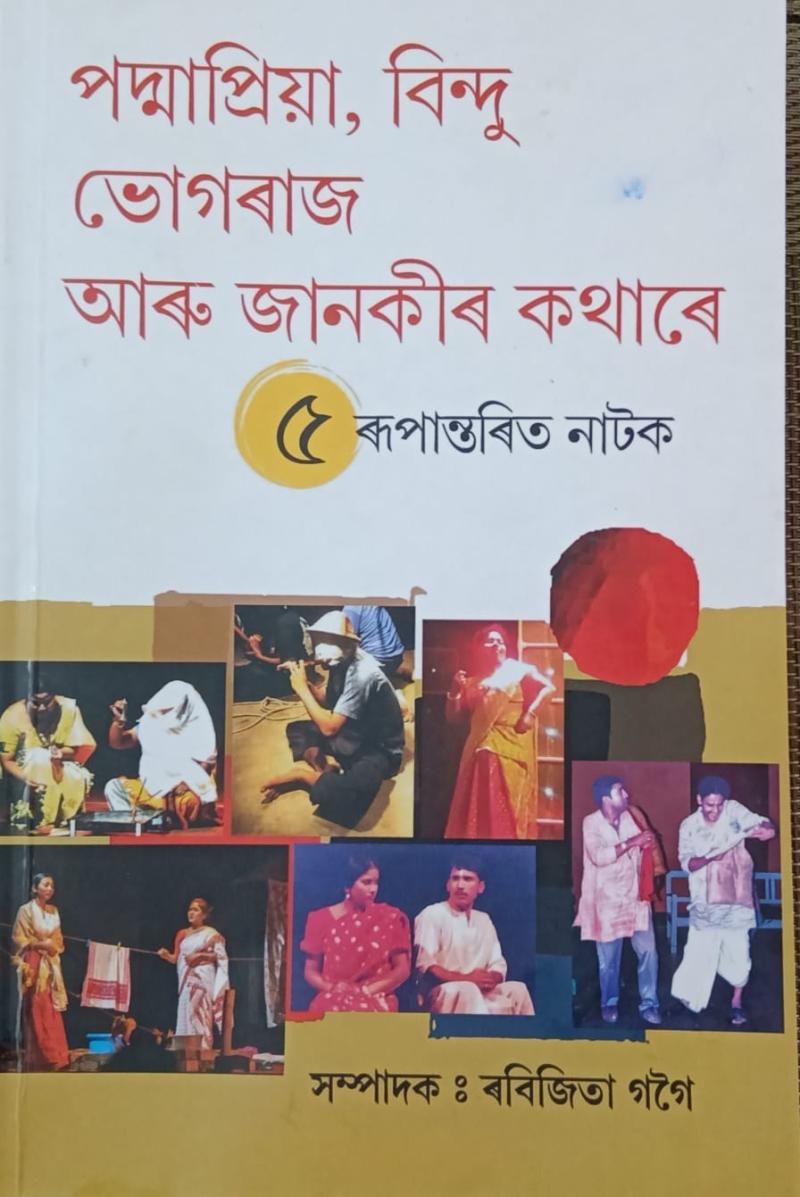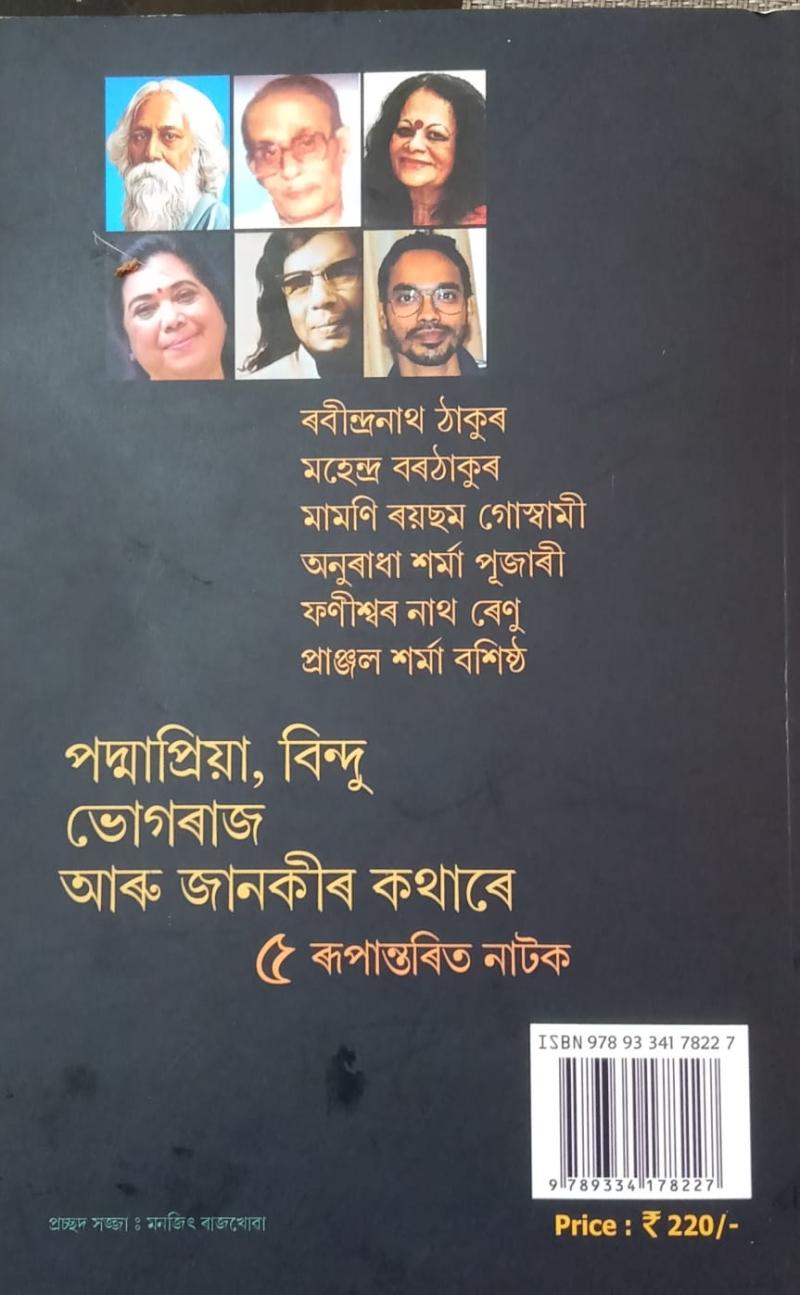Words do travel. Spoken words mostly travel from mouth to mouth, while written words may travel from book to book and from one reader to another. Meaningful literary words, however, have multiple wings to make their voyage in various forms, mediums to shape diversified contents in the universe of creativity. At times they may travel from the world of fiction to different form of art and undergo metamorphosis into a new creation.
In an innovative attempt, a few short stories of Indian literature have made their voyage to the field of drama in the curated hands of noted theatre personality of Assam, Robijita Gogoi, who has edited the Padmapriya, Bindu, Bhograj Aru Janokir Kothare, a collection of five dramatization of stories with different flavour and substances, recently published by Jirsong Theatre Publication, Guwahati.
The collection of dramatizations include, (1) Devipeethaor Tez, the dramatization of Mamoni Raisom Goswami’s celebrated short story with the same name; (2) Jatra Subha Haok, derived from two short stories-“Na Jane Kohi Besh Mey” by Phaniswar Nath Renu and “Sukh-Dukh” by Pranjal Sharma Basistha, (3) Neota Nirman from Hay, written by Assamese short-story writer and playwright Mahendra Borthakur, (4) Iti Mrinalini, the dramatization of Rabindranath Tagore’s celebrated short story “Streer Patra”, and (5) Baduli from the original short story with the same name written by eminent writer Anuradha Sarma Pujari.
Of these, Robijita Gogoi herself completed dramatization of “Devipeethar Tej”, “Jatra Subha Haok” and “Iti Mrinalini”. The dramatization of “Baduli” is by Pankaj Jyoti Bhuyan, while Neota Nirman is a joint effort of Robijita Gogoi and Mrinal Jyoti Goswami.
This attempt of extension from literature to the field of performing art is, however, an intense effort. Robijita and two other theatre personalities have portrayed unique expertise in using language as a tool to keep originality of the literary essence, while doing the dramatization part of the work. Dialogues with different tone and flavour to express different temperament plays a significant role to translate the substance. The dual efforts of making the drama content interesting for a larger audience while keeping the literary sense unscathed, are indeed difficult tasks as contents of original literary works are of diversified tastes.
For example, both Devipeethar Tej and Iti Mrinalini are set on the backdrop of the protagonists with indomitable spirit to break barriers of patriarchal norms of the society. The two female protagonists of both drama question patriarchy by their action. Here dialogues with intense thought and meaning plays the most vital role. The original tone and flavour of literary work is omnipresent in the drama version of both “Devipeethar Tej” and “Iti Mrinalini”.
Baduli is set on the temperament of typical mentality of a worthless and ambitious lady without substance, who ironically happens to be the wife of a senior police officer. Unlike Devipeethar Tej and Iti Mrinalini, the language construct in Baduli is on farce and satire to enthral the audience. The dialogue of this drama is full of wit, humour, and irony.
Again, Jatra Subha Haok is set on conversation among few co-travellers who take part in light conversation in a bogie of a running train. These travellers belong to different communities and speak different languages. However, inside the bogie, they speak in a communicative language with a typical accent of their own languages. These co-travellers have their different experiences of life which unfold in their conversation. A poet, who believes in daily horoscopes and love to act accordingly, is the key protagonist of the drama. Apart from setting the drama on the backdrop of a running train-bogie, which seems interesting and innovative, the multi-lingual structure of the novel is also one of the prominent features to draw immediate attention of intelligent audience.
Neota Nirman is set on the concept of run for your life in a competitive world and obviously dialogue is playing a significant role to translate the original short story into an interesting drama.
The collection is important as it marks a coordinated effort of giving literature an extended form and to take literary work of leading writers to a wider audience. The effort encompasses transcending language boundaries of Assamese literature, which is also a laudable task in contemporary literature of theatre.
Picking up fiction with different temperament and taste, is another important aspect of the collection, which speaks volume about the passion of Rabijita Gogoi to experiment on stage with vivid ideas and thought. The Padmapriya, Bindu, Bhograj Aru Janokir Kothare is a successful experimentation of dramatization of literary works.

